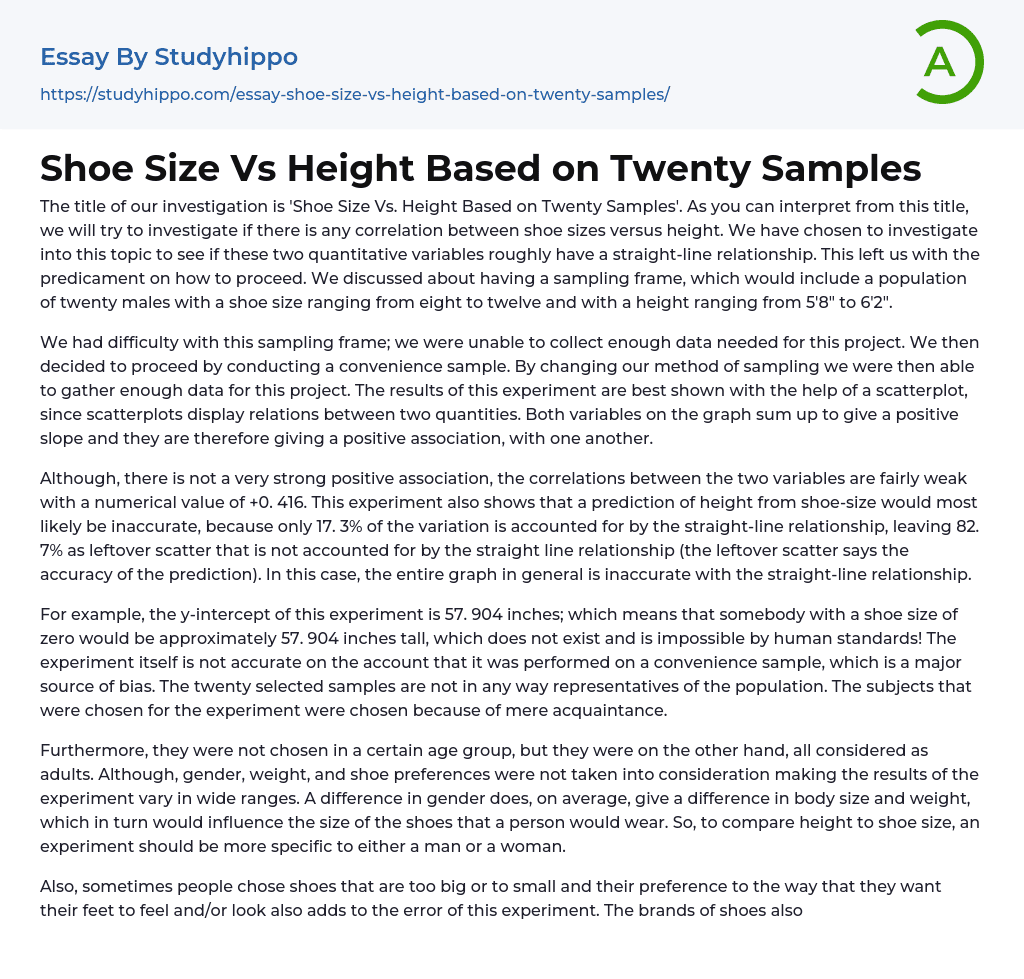

Shoe Size Vs Height Based on Twenty Samples Essay Example
The title of our investigation is 'Shoe Size Vs. Height Based on Twenty Samples'. As you can interpret from this title, we will try to investigate if there is any correlation between shoe sizes versus height. We have chosen to investigate into this topic to see if these two quantitative variables roughly have a straight-line relationship. This left us with the predicament on how to proceed. We discussed about having a sampling frame, which would include a population of twenty males with a shoe size ranging from eight to twelve and with a height ranging from 5'8" to 6'2".
We had difficulty with this sampling frame; we were unable to collect enough data needed for this project. We then decided to proceed by conducting a convenience sample. By changing our method of sampling we were then able to gather enough data for
...this project. The results of this experiment are best shown with the help of a scatterplot, since scatterplots display relations between two quantities. Both variables on the graph sum up to give a positive slope and they are therefore giving a positive association, with one another.
Although, there is not a very strong positive association, the correlations between the two variables are fairly weak with a numerical value of +0. 416. This experiment also shows that a prediction of height from shoe-size would most likely be inaccurate, because only 17. 3% of the variation is accounted for by the straight-line relationship, leaving 82. 7% as leftover scatter that is not accounted for by the straight line relationship (the leftover scatter says the accuracy of the prediction). In this case, the entire graph in general i
inaccurate with the straight-line relationship.
For example, the y-intercept of this experiment is 57. 904 inches; which means that somebody with a shoe size of zero would be approximately 57. 904 inches tall, which does not exist and is impossible by human standards! The experiment itself is not accurate on the account that it was performed on a convenience sample, which is a major source of bias. The twenty selected samples are not in any way representatives of the population. The subjects that were chosen for the experiment were chosen because of mere acquaintance.
Furthermore, they were not chosen in a certain age group, but they were on the other hand, all considered as adults. Although, gender, weight, and shoe preferences were not taken into consideration making the results of the experiment vary in wide ranges. A difference in gender does, on average, give a difference in body size and weight, which in turn would influence the size of the shoes that a person would wear. So, to compare height to shoe size, an experiment should be more specific to either a man or a woman.
Also, sometimes people chose shoes that are too big or to small and their preference to the way that they want their feet to feel and/or look also adds to the error of this experiment. The brands of shoes also play a role because some brands make shoe sizes that are bigger or smaller than the rest (which would explain why people try on shoes before they buy them to make sure that it fits), and so the shoe size can be influenced by the brand. So to summarize and to put
it bluntly, the samples were not random, were not representative of a population and they were not representative of a group of any sort.
The data obtained is biased in many ways, and a prediction based on this data would be very inaccurate because of this. To conclude, even if the data obtained wasn't biased (SRS), and the results were the same, a prediction would still be inaccurate because there is a weak correlation between height and shoe size. Surely, in a proper experiment, there would be a greater correlation between height and shoe size and predictions would be far more accurate than this experiment because hopefully someone would make sure that there data is not biased.
- Normal Distribution essays
- Probability Theory essays
- Variance essays
- Experiment essays
- Explorer essays
- Hypothesis essays
- Observation essays
- Qualitative Research essays
- Research Methods essays
- Theory essays
- Clothing essays
- Cosmetic Surgery essays
- Fashion design essays
- Footwear essays
- Agriculture essays
- Albert einstein essays
- Animals essays
- Archaeology essays
- Bear essays
- Biology essays
- Birds essays
- Butterfly essays
- Cat essays
- Charles Darwin essays
- Chemistry essays
- Dinosaur essays
- Discovery essays
- Dolphin essays
- Elephant essays
- Eli Whitney essays
- Environmental Science essays
- Evolution essays
- Fish essays
- Genetics essays
- Horse essays
- Human Evolution essays
- Isaac Newton essays
- Journal essays
- Linguistics essays
- Lion essays
- Logic essays
- Mars essays
- Methodology essays
- Mineralogy essays
- Monkey essays
- Moon essays
- Mythology essays
- Noam Chomsky essays
- Physics essays
- Plate Tectonics essays



